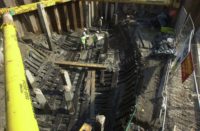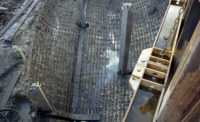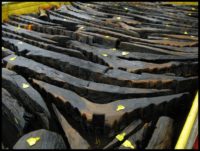 The Newport Ship, the largest, best-preserved 15th century ship ever found, is being pieced back together like a giant jigsaw puzzle in a warehouse in Newport, Wales.
The Newport Ship, the largest, best-preserved 15th century ship ever found, is being pieced back together like a giant jigsaw puzzle in a warehouse in Newport, Wales.
The remains of the massive merchant ship about 400 tons displacement and 100 feet long were discovered in June 2002 during construction of an arts center on the banks of the River Usk. Archaeologists from the Glamorgan-Gwent Archaeological Trust (GGAT) built a coffer-dam around the site and excavated the remains of the large vessel capable of carrying a load of about 200 tons.
 The ship was not laden with cargo, belongings or even ballast. It was in dock when it gave up the ghost, slated for repair or demolition. One coin – a French petit blanc — placed in the keel likely for good luck, dated the ship to the late 1440s. A smattering of other artifacts were found, including a gaming piece, a brass fitting from a helmet, stone shot for a swivel gun, a bilge bump and the ubiquitous nit comb. The artifacts and tree-ring analysis of the timbers indicate the ship was built in the Basque Country in 1449, and carried wine on the Lisbon-Bristol trade route for the next 20 years. While it was docked in Newport, the ship collapsed and the hull flooded. The part of the ship that could be easily accessed was disassembled leaving the lower part of the hull for archaeologists to discover 600 years later.
The ship was not laden with cargo, belongings or even ballast. It was in dock when it gave up the ghost, slated for repair or demolition. One coin – a French petit blanc — placed in the keel likely for good luck, dated the ship to the late 1440s. A smattering of other artifacts were found, including a gaming piece, a brass fitting from a helmet, stone shot for a swivel gun, a bilge bump and the ubiquitous nit comb. The artifacts and tree-ring analysis of the timbers indicate the ship was built in the Basque Country in 1449, and carried wine on the Lisbon-Bristol trade route for the next 20 years. While it was docked in Newport, the ship collapsed and the hull flooded. The part of the ship that could be easily accessed was disassembled leaving the lower part of the hull for archaeologists to discover 600 years later.
Bob Evans, chairman of the Friends of the Newport Ship:
“There are no other surviving vessels from the early 15th century; a time when ship design was developing rapidly and we have much to learn from the way in which she was built and how she would have sailed”.
 At first the plan was to preserve only a few representative timbers, but when the discovery of the Newport Ship made the press, a public campaign persuaded the Welsh National Assembly to budget the time and £3.5 million for a full excavation. In order to preserve the ship, it was taken apart timber by timber, each piece numbered and placed into freshwater tanks for storage. The last piece of the puzzle, massive keel, had to be cut into sections. It was removed in November 2002.
At first the plan was to preserve only a few representative timbers, but when the discovery of the Newport Ship made the press, a public campaign persuaded the Welsh National Assembly to budget the time and £3.5 million for a full excavation. In order to preserve the ship, it was taken apart timber by timber, each piece numbered and placed into freshwater tanks for storage. The last piece of the puzzle, massive keel, had to be cut into sections. It was removed in November 2002.
It takes a long, long time to stabilize waterlogged shipwrecks. The Mary Rose was hosed down in polyethylene glycol (PEG) for three decades. Because the Newport Ship was recovered in approximately 3,000 pieces rather than as a whole hull, the timbers could be soaked simultaneously and evenly in the tanks. Conservators soaked the timbers an ammonium citrate solution to remove iron salts before soaking in PEG. Then they shortened the treatment period (and cost in materials; PEG is a petroleum product and very expensive) by freeze-drying the PEG-saturated timbers.
 The conservation process is almost complete now and reassembly is the next frontier. The total weight of the timbers is more than 25 tons. Friends of the Newport Ship are working with experts from Swansea University to design and built a cradle as a support structure
The conservation process is almost complete now and reassembly is the next frontier. The total weight of the timbers is more than 25 tons. Friends of the Newport Ship are working with experts from Swansea University to design and built a cradle as a support structure
“We have received two further shipments of dried timbers during the year so that we now have around three quarters of the recovered timbers preserved and ready for reassembly,” explained Mr Evans.
“We aim to have the remaining timbers back at the Newport Ship Centre by the end of 2020. The latest shipment includes some of the big framing timbers which are very impressive in terms of their size and the high standard of carpentry they exhibit. […]
He added: “We do not want to put it together in the wrong way or have to take it apart again, so we must be certain that we know exactly how each timber fits together before we start.
“Work continues on finding a building in the Newport area which is big enough to house the Ship and we hope to make an announcement on this in a few months’ time.”